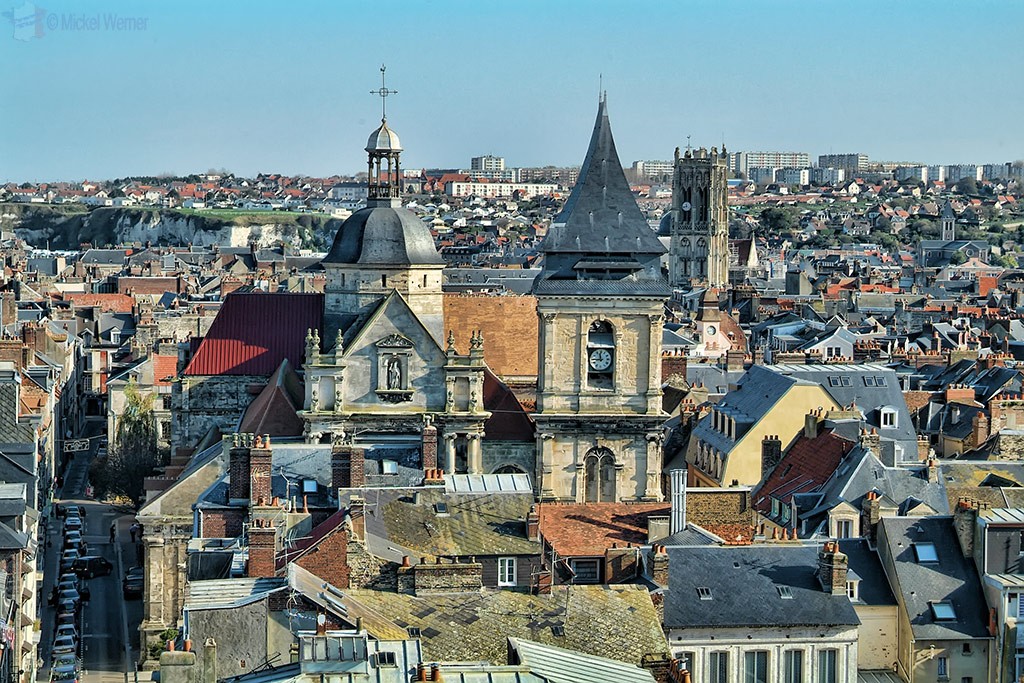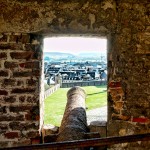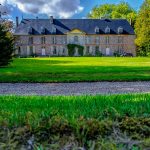Dieppe is a small harbour city (some 40,000 inhabitants) with an active fishing fleet, a ferry to the United Kingdom (Newhaven), an enormous fortress/castle and a nice looking inner city. Dieppe was founded in the year 1060 as a small fishing village, but already in 910, the Vikings started a settlement.
This city/town forms part of one of the French legs of the Santiago de Compostela pilgrimage route.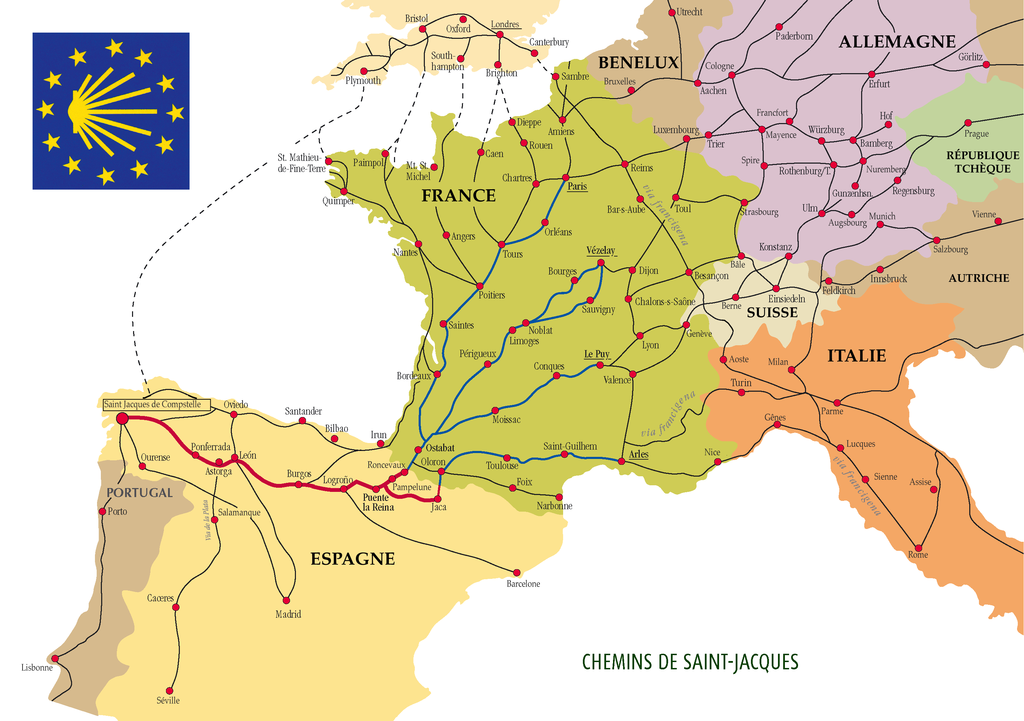
Santiago de Compostela pilgrimage routes
Dieppe, like most of the coastal places in Normandy is located in-between the high cliffs.
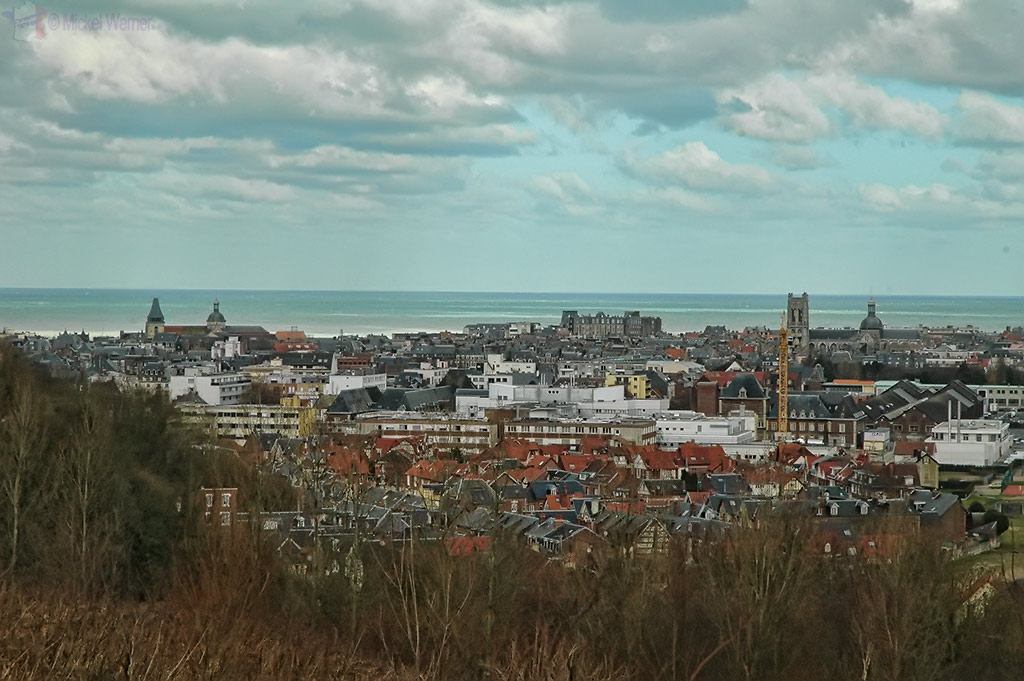
The city’s visual landscape is dominated by the castle perched on top of the cliffs and overlooking the city. The original castle was built in 1188 (but was destroyed and rebuilt).
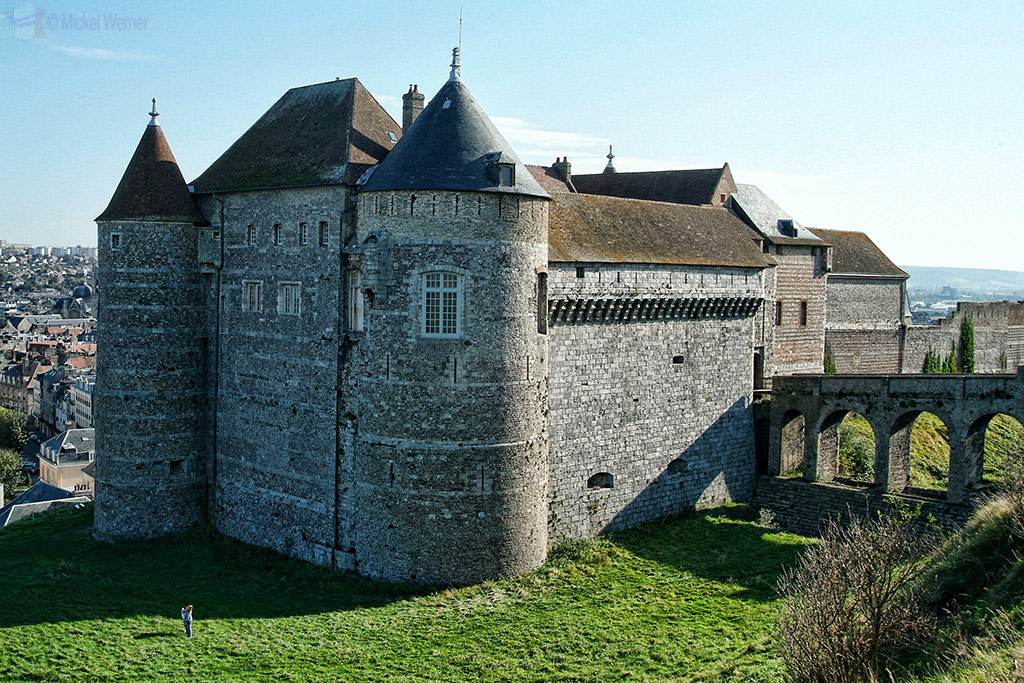
For more information about the castle, click here to read our article on the castle.
Inside the City
The inner part of Dieppe is old, despite several bombings during World War II. The Saint-Remy church is quite a distinctive church, and the tower is from the original church which was built in the 13th century.
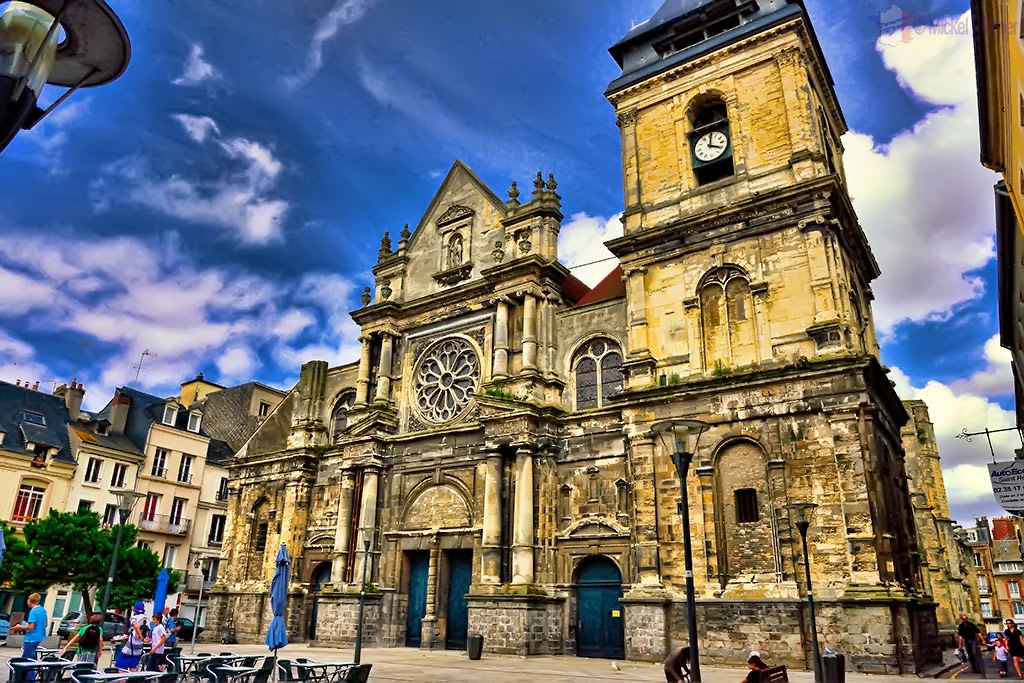
The church looks more like it should be in Mexico. The rebuilding of the church started in 1522 using the original tower as base and was finished in 1545.
On the water side, there is a long beach (like anywhere in Upper Normandy, the beach is made from pebbles) and lots of parking space and grass fields used for special events.
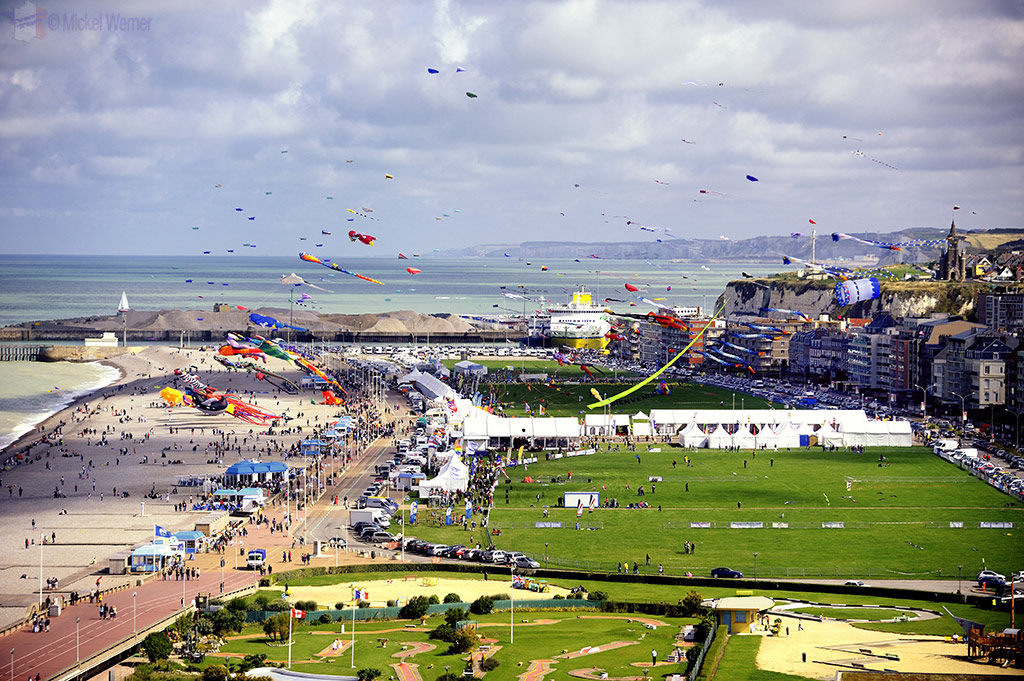
In contrast with most beaches in Normandy, there a no, or few, huts. You will find a few shops and food vendors, emergency services and book reading facilities.

At the bottom of the cliff and its castle is a public swimming pool that is filled with warm seawater.
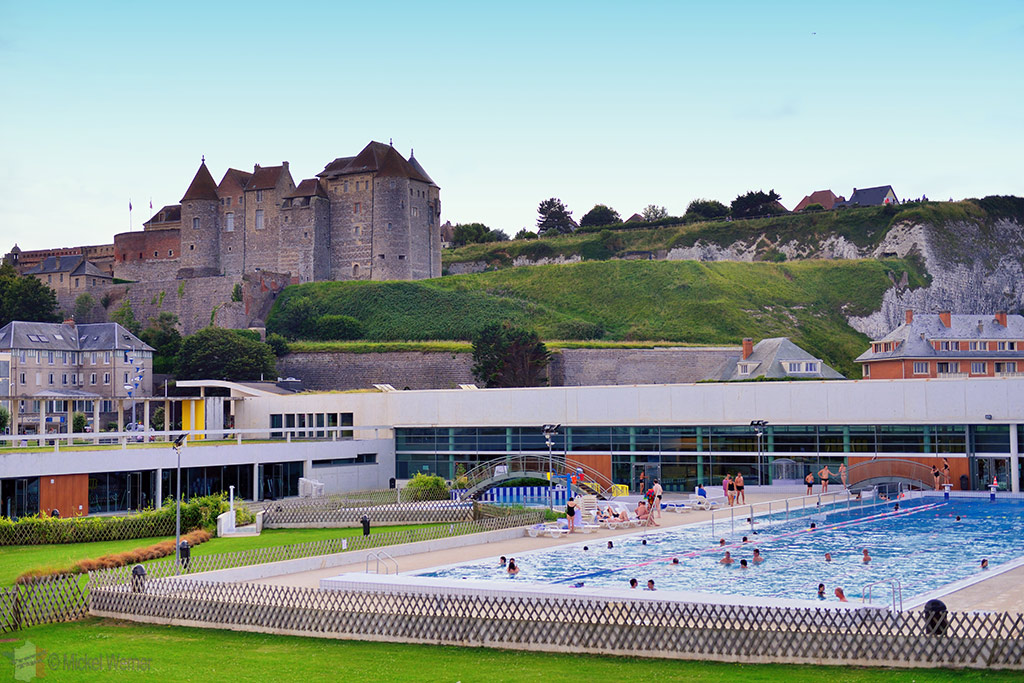
On the other side of the beach, where the L’Arques river flows into the sea, is where the harbours start. The biggest ships that arrive here are by far the ferries that cross the Channel to the UK (Newhaven). When a ferry is in, it dominates the view on that side of the city.

In the background you can see the tall white cliffs of Normandy.
Alongside the river are the harbours, for commercial (fishing and cargo) boats, and a rather big pleasure boat marina.
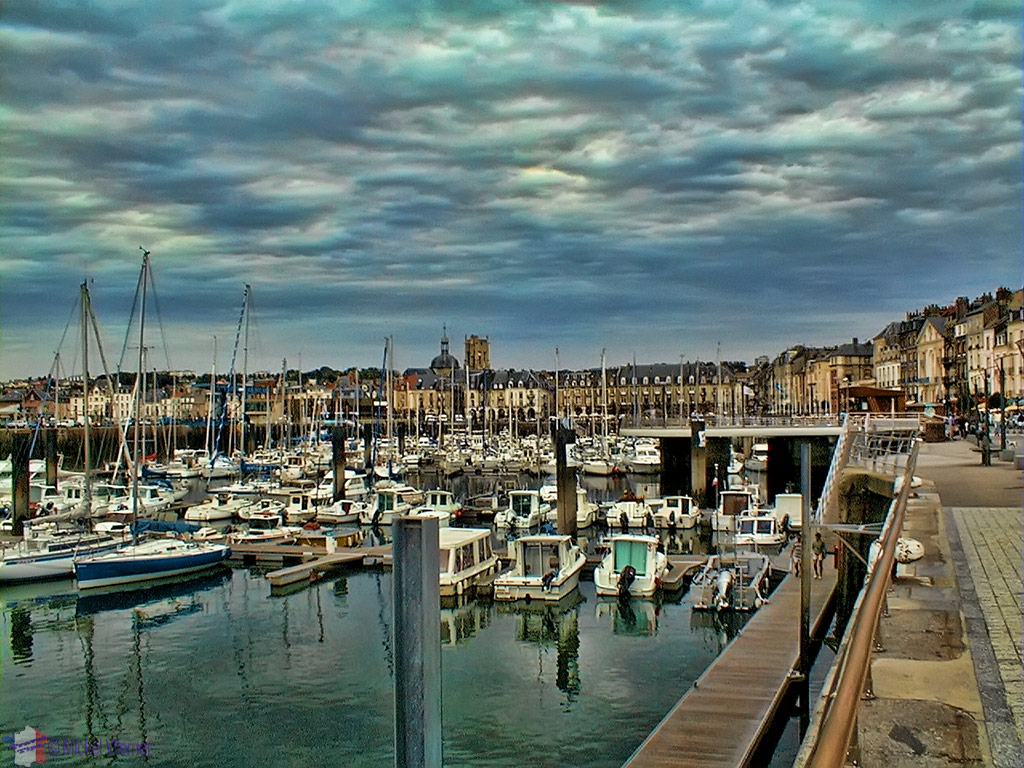
Dieppe lighthouse
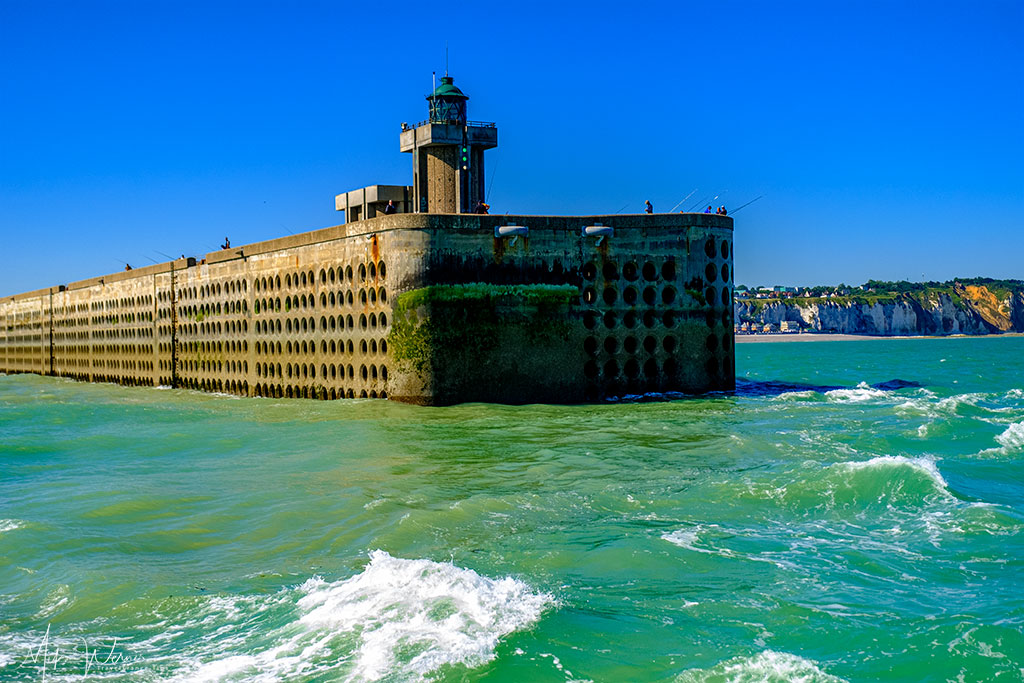
The lighthouse marking the entrance to the harbour of Dieppe is colorful. It had been destroyed many times, mostly when it was being moved when they extended the seawall, but also towards the end of WWII by the Germans.
The current lighthouse was built mid 1990 and it measures 8 meters high.
The marina has a busy road and promenade alongside it, and on the other side of the road you will find many restaurants:
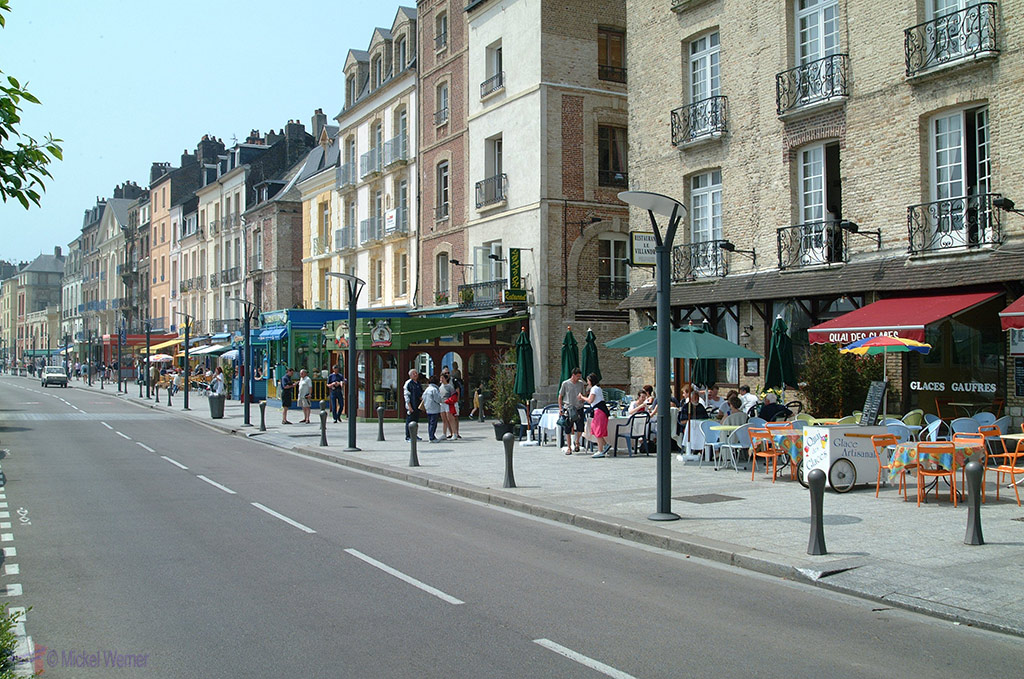
Most restaurants, as would be expected, have as speciality fish. In the summer, the restaurant strip can be quite lively, with music and most people sitting outside on the terraces.
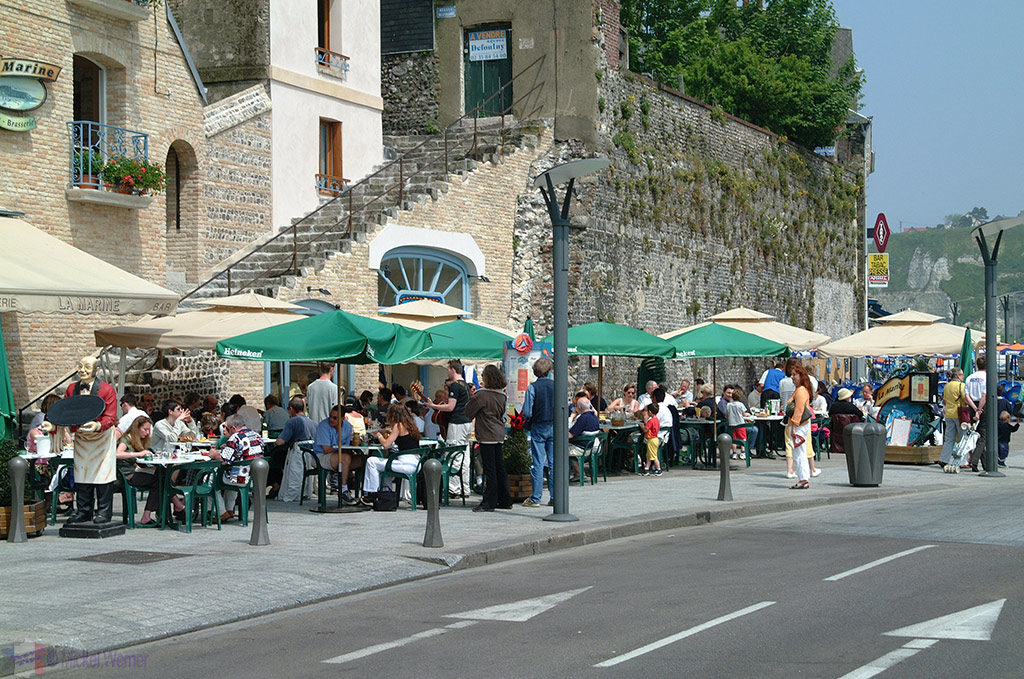
The view from these restaurants is that of the harbour, pleasure boat marina and an occasional cargo ship passing through.
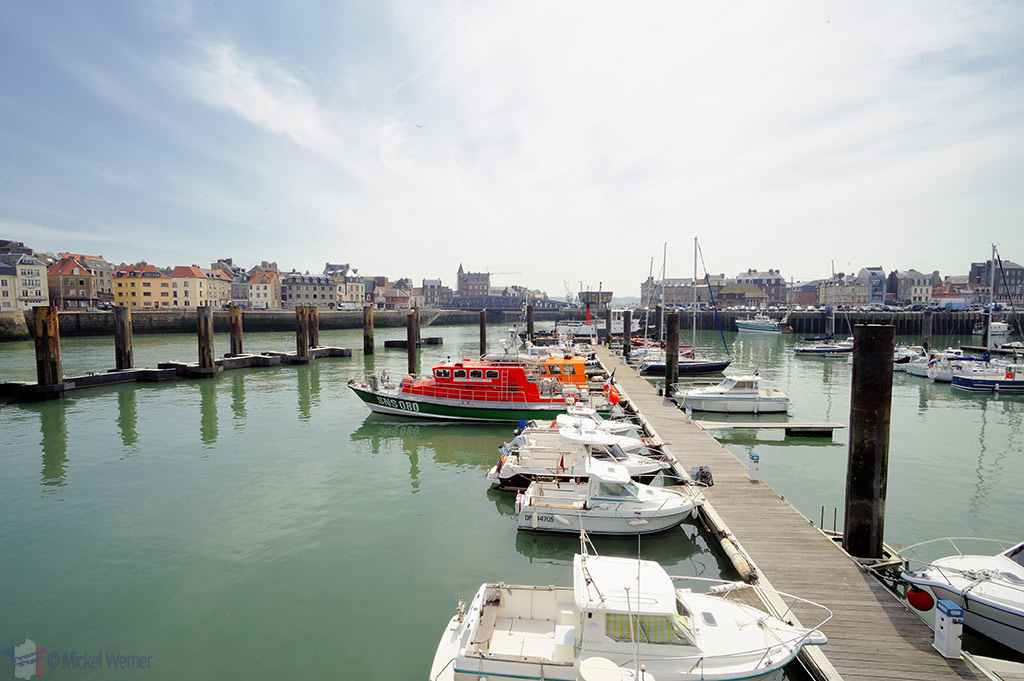
On the East side of the harbours is the start of a hill and all the dock businesses, like ship chandlers, and many bars catering to sailors.

Notre-Dame-de-Bon-Secours church
Above the hill is a solitary church dominating the exit of the harbour. The church, Notre-Dame-de-Bon-Secours (our Lady of the Good Rescue), was built in 1876 and is dedicated to the sailors lost to the sea.
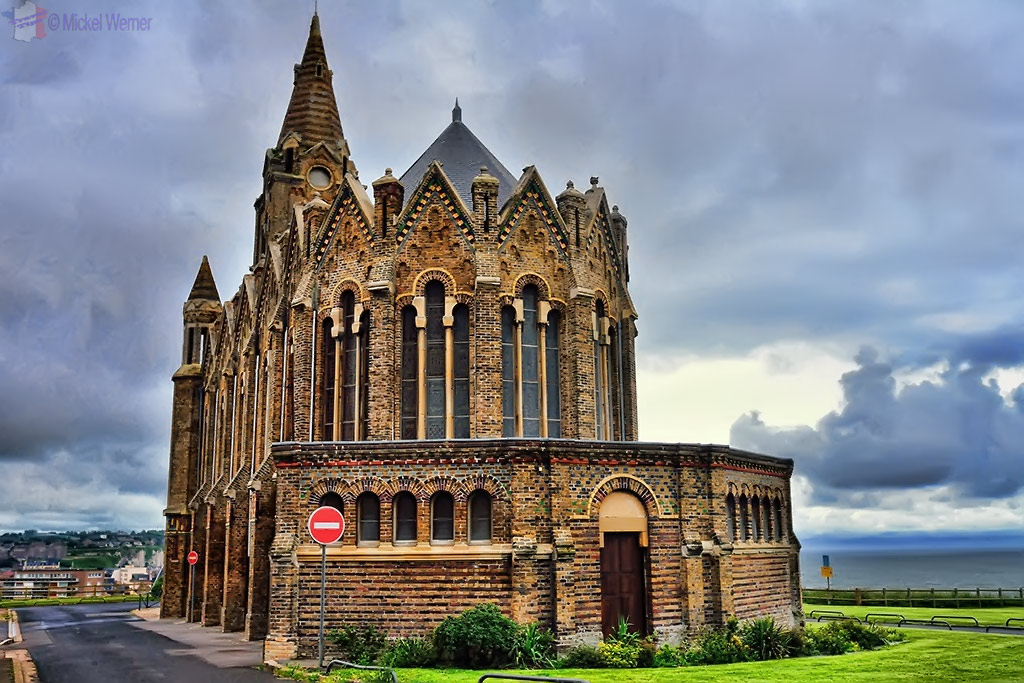
Inside the city itself are a few pedestrian streets. On Saturday morning, there is a very big open air market, with anything that can be sold on sale. From clothes, to food, to toys, to even live animals. Many farmers from the area come here to sell their fresh produce.
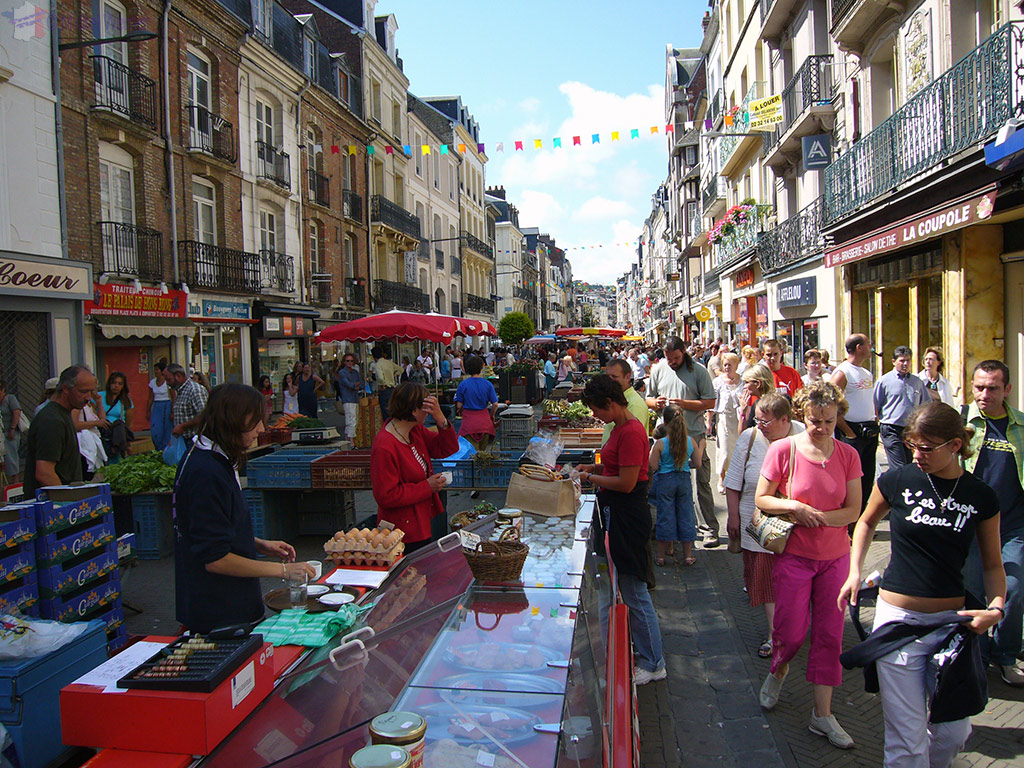
On the other days, during the summer, the pedestrian streets are the home for the restaurants, cafes and bars.
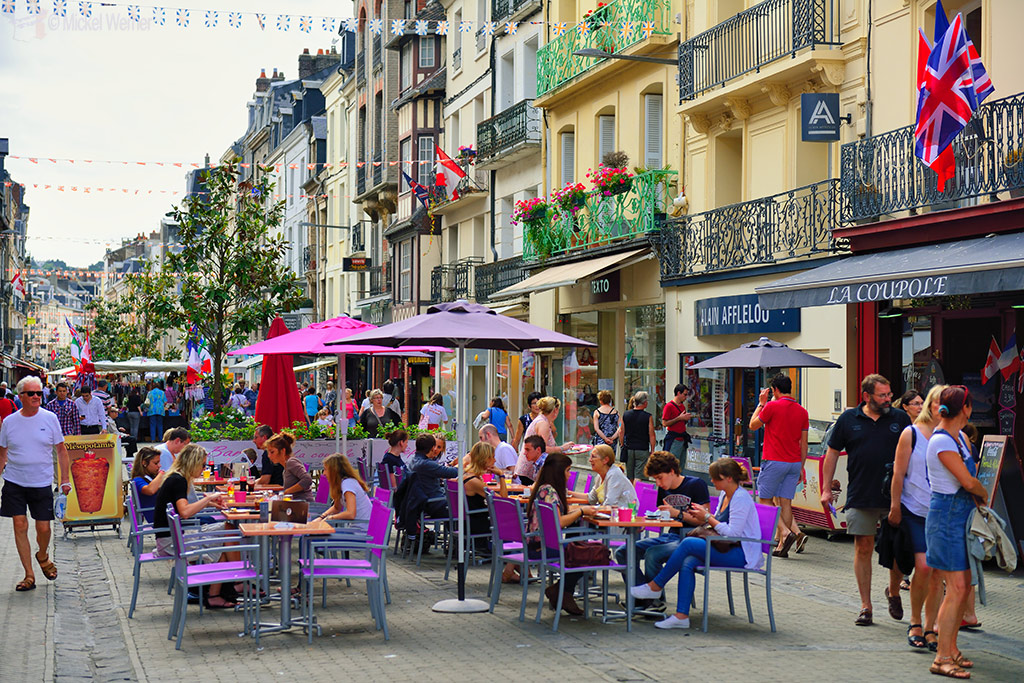
When walking the city, you will find many old, or “oldish” buildings. Streets are narrow and when you look in between buildings, you often find some rare architectures.
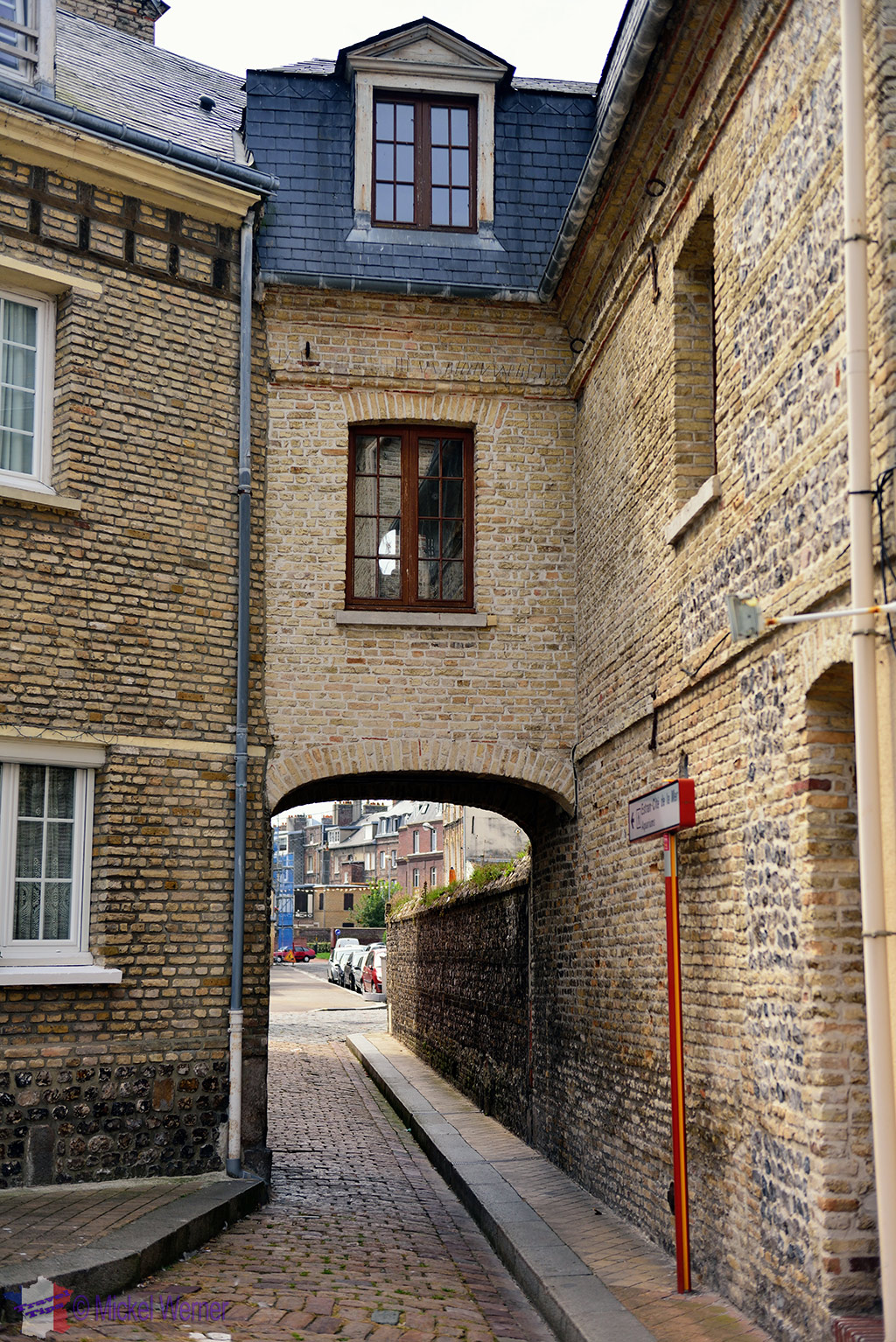
Although Dieppe was heavily bombed during the Second World War, there are still some older buildings left standing.
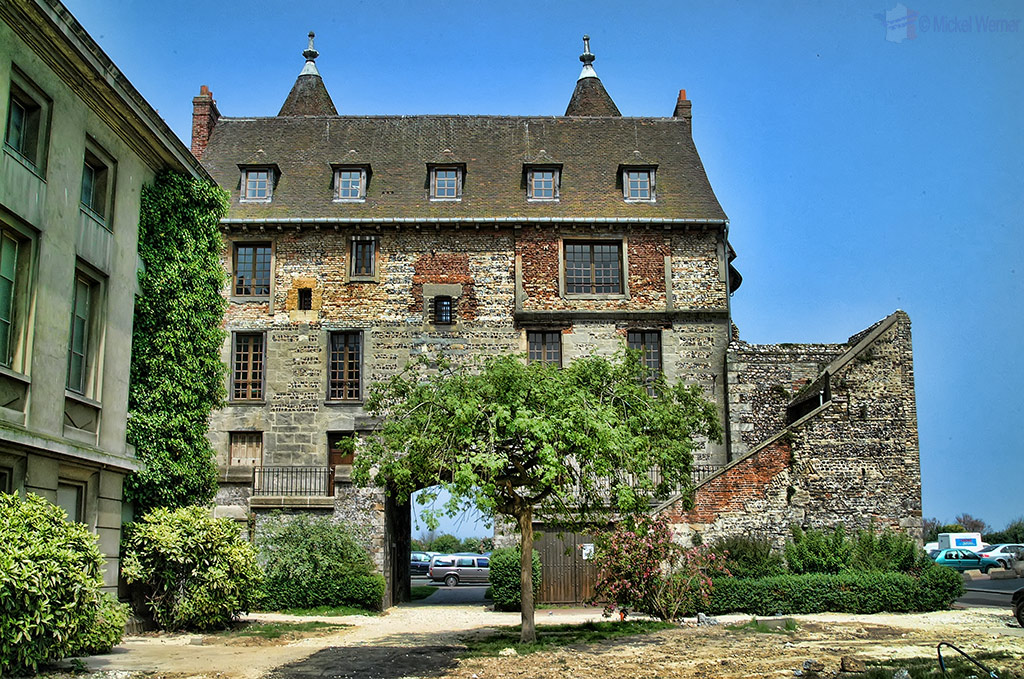
Golf Club
The city also hosts France’s 7th oldest golf course. Made by the English in 1897 (it’s easy to come here thanks to the twice daily ferry), the 18 holes run along the majestic cliffs and the English Channel.
At some of the holes it is easy to see your golf ball head into the sea. The golf links now lie on top of several bunkers; real bunkers from WWII.

Dieppe and Canada
There has been a long standing relationship between Dieppe and Canada. The relationship culminated in the tragic end of WWII’s “Operation Jubilee”, an attempt by the Allied Forces to occupy Dieppe (1942, years before D-Day). On the 19th of August 1942, more than 2,000 Canadian soldiers died trying to take the city, a struggle that the city of Dieppe will never forget.
This is why you will find many reminders all over the city that Canada has a very special place in the hearts of the people of Dieppe.
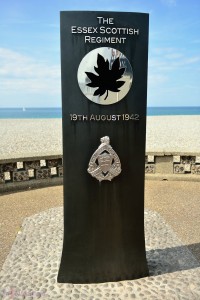
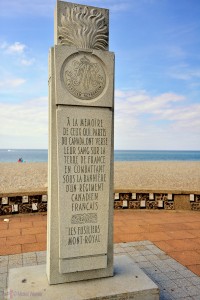
It’s therefore no surprise when you walk inside the city to see Canadian flags or the maple leaf symbol of Canada displayed on buildings and signs.
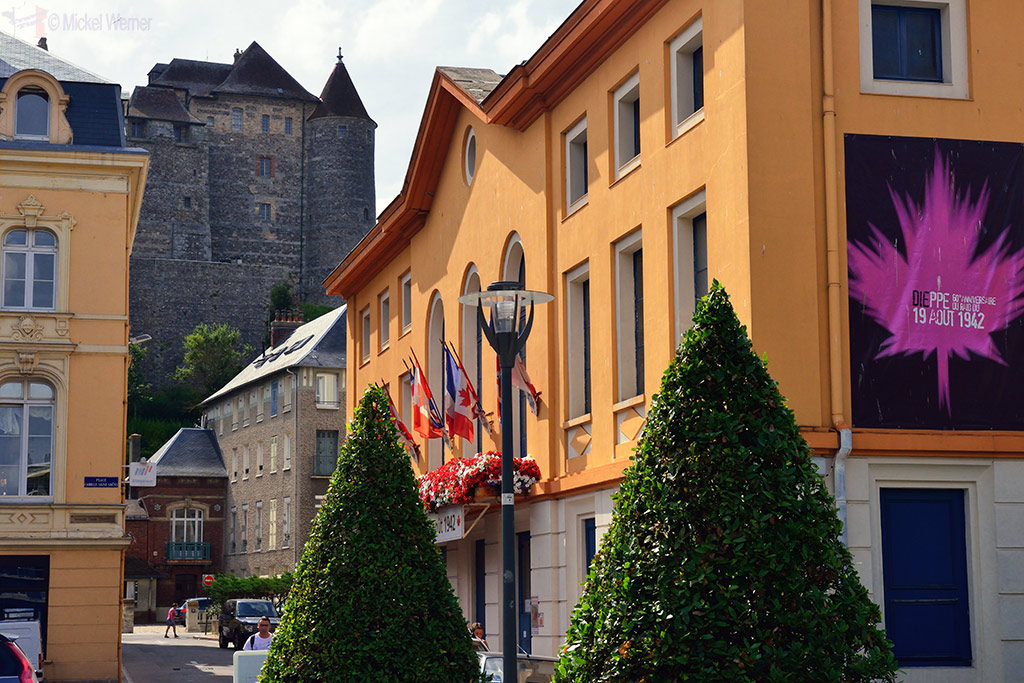
GR21
Dieppe is part of the long distance hiking path, GR21, which brings you from Le Havre to Le Treport via the cliffs over some 180 kms.
Dieppe and the Artists
Dieppe in Normandy was a popular place for artists to come and apply their art. Here is a list, non exhaustive, of the artists that painted in Dieppe.
A link (“⇠”) to the artist’s works will appear when published (a “*” indicates that the artist did not work directly in Dieppe, instead worked in nearby villages):
- 🇫🇷 Blanche, Jacques-Emile ⇠
- 🇺🇸 Boggs, Frank Myers ⇠
- 🇷🇺 Bogolyubov, Alexey (Alexei) ⇠
- 🇬🇧 Bonington, Richard Parkes ⇠
- 🇫🇷 Boudan, Louis ⇠
- 🇫🇷 Boudin, Eugene-Louis ⇠
- 🇬🇧 Boys, Thomas Shotter ⇠
- 🇫🇷 Braque, Georges ⇠
- 🇫🇷 Bruelle, Gaston ⇠
- 🇫🇷 Burel, Henry E. ⇠
- 🇬🇧 Burgess Jr, John ⇠
- 🇺🇸 Butler, Theodore Earl ⇠
- 🇬🇧 Callow, William ⇠
- 🇬🇧 Cameron, David Young ⇠
- 🇺🇸 Chapman, Conrad Wise ⇠
- 🇫🇷 Ciceri, Eugene ⇠
- 🇬🇧 Conder, Charles ⇠
- 🇬🇧 Cooke, Edward William ⇠
- 🇫🇷 Corot, Jean-Baptiste Camille ⇠
- 🇬🇧 Cotman, John Sell ⇠
- 🇫🇷 Courbet, Gustave ⇠
- 🇬🇧 Cox Sr, David ⇠
- 🇫🇷 Cyr, Georges Albert ⇠
- 🇬🇧 Cundall, Charles ⇠
- 🇫🇷 Daubigny, Charles-Francois ⇠
- 🇦🇺 Davies, David ⇠
- 🇫🇷 de Jolimont, Theodore Basset ⇠
- 🇬🇧 Dibdin, Thomas Colman ⇠
- 🇬🇧 Dommersen, William ⇠
- 🇳🇱 Doomer, Lambert ⇠
- 🇫🇷 Dubourg, Louis-Alexandre ⇠
- 🇮🇪 Dunlop, Ronald Ossory ⇠
- 🇬🇧 Fergusson, John Duncan ⇠
- 🇫🇷 Friesz, Othon ⇠
- 🇫🇷 Garneray, Ambroise Louis ⇠
- 🇫🇷 Gauguin, Paul ⇠
- 🇫🇷 Goeneutte, Norbert ⇠
- 🇫🇷 Gonzales, Eva ⇠
- 🇬🇧 Gosse, Sylvia ⇠
- 🇫🇷 Guerard, Henri ⇠
- 🇫🇷 Guiaud, Jacques ⇠
- 🇫🇷 Guillaumin, Armand ⇠
- 🇫🇷 Haquette, Georges Jean-Marie ⇠
- 🇬🇧 Hardy, Thomas Bush ⇠
- 🇫🇷 Hervier, Louis Adolphe ⇠
- 🇫🇷 Hoguet, Charles ⇠
- 🇬🇧 Huet, Paul ⇠
- 🇫🇷 Isabey, Eugene ⇠
- 🇬🇧 Jamieson, Alexander ⇠
- 🇳🇱 Jongkind, Johan Barthold ⇠
- 🇬🇧 Kay, James ⇠
- 🇷🇺 Korovin, Konstantin ⇠
- 🇫🇷 Kuwasseg, Charles Euphrasie ⇠
- 🇫🇷 Le Secq, Henri ⇠
- 🇫🇷 Lebourg, Albert ⇠
- 🇬🇧 Lee-Hankey, William ⇠
- 🇫🇷 Lemaitre, Leon-Jules ⇠
- 🇫🇷 Letellier, Emile-Andre ⇠
- 🇫🇷 Loir, Luigi ⇠
- 🇫🇷 Loiseau, Gustave ⇠
- 🇫🇷 Luce, Maximilien ⇠
- 🇫🇷 Maclet, Elisee ⇠
- 🇫🇷 Madelain, Gustave ⇠
- 🇫🇷 Manzana-Pissarro, Georges Henri ⇠
- 🇫🇷 Marquet, Albert ⇠
- 🇫🇷 Mathon, Emile Louis ⇠
- 🇫🇷 Maze, Paul ⇠
- 🇬🇧 McEvoy, Ambrose ⇠
- 🇫🇷 Michallon, Achille Etna ⇠
- 🇫🇷 Monet, Claude ⇠
- 🇬🇧 Montague, Alfred ⇠
- 🇫🇷 Moret, Henry ⇠
- 🇫🇷 Mozin, Charles Louis ⇠
- 🇫🇷 Noel, Jules Achille ⇠
- 🇺🇸 Norton, William Edward ⇠
- 🇫🇷 Pissarro, Camille ⇠
- 🇫🇷 Pissarro, Lucien * ⇠
- 🇺🇸 Prendergast, Maurice ⇠
- 🇬🇧 Prout, Samuel ⇠
- 🇫🇷 Renoir, Pierre-Auguste ⇠
- 🇬🇧 Roberts, David ⇠
- 🇬🇧 Sickert, Walter Richard ⇠
- 🇬🇧 Smith, Matthew Arnold Bracy ⇠
- 🇬🇧 Smallwood, William Frome * ⇠
- 🇬🇧 Stanfield, Clarkson Frederick ⇠
- 🇳🇴 Thaulow, Fritz ⇠
- 🇫🇷 Thornley, Georges William ⇠
- 🇧🇪 Timmermans, Louis-Etienne ⇠
- 🇬🇧 Turner, William ⇠
- 🇨🇭 Vallotton, Felix ⇠
- 🇫🇷 Vernet, Claude-Joseph ⇠
- 🇫🇷 Vollon, Antoine ⇠
- 🇩🇪 Weber, Theodore Alexander ⇠
- 🇺🇸 Whistler, James McNeill ⇠
Conclusion
Dieppe is quite an interesting city to visit. It’s steeped in history, a beautiful castle and churches and some very nice restaurants. You can get there quite easily by car and there is a direct ferry service to the UK.
Related Posts
- 10000
- 10000
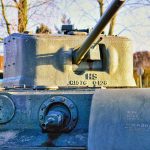 Although the Lower part of Normandy saw the biggest brunt of the WWII battles, with D-Day and the immediate battles that followed, the Upper part of Normandy saw its fair share of fighting. And during WWI, it was one of the battlefronts. Therefore throughout Normandy, at almost any hamlet, village,…
Although the Lower part of Normandy saw the biggest brunt of the WWII battles, with D-Day and the immediate battles that followed, the Upper part of Normandy saw its fair share of fighting. And during WWI, it was one of the battlefronts. Therefore throughout Normandy, at almost any hamlet, village,… - 10000
 Watermills have been used over the centuries around the world to regulate water levels (notably in The Netherlands) or to grind wheat, corn and other products. For a watermill to exist you not only need a river, but you need especially a fast flowing river. Normandy, particularly Upper Normandy, has…
Watermills have been used over the centuries around the world to regulate water levels (notably in The Netherlands) or to grind wheat, corn and other products. For a watermill to exist you not only need a river, but you need especially a fast flowing river. Normandy, particularly Upper Normandy, has… - 10000
- 10000
 Fecamp was once a main hub for commercial fishing. Now there is a museum dedicated to the fishing industry installed in one of the main fishing factories. It's worth a visit.
Fecamp was once a main hub for commercial fishing. Now there is a museum dedicated to the fishing industry installed in one of the main fishing factories. It's worth a visit.
